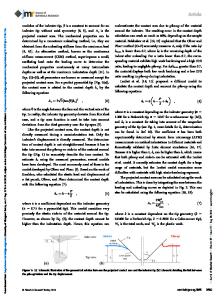Contact Area Evolution During an Indentation Process
- PDF / 279,211 Bytes
- 8 Pages / 612 x 792 pts (letter) Page_size
- 81 Downloads / 401 Views
Welcome
MATERIALS RESEARCH
Comments
Help
Contact area evolution during an indentation process Kangjie Li Materials Science Program, Department of Mechanical Engineering, University of Rochester, Rochester, New York 14627
T. W. Wu IBM Research Division, Almaden Research Center, San Jose, California 95120
J. C. M. Li Materials Science Program, Department of Mechanical Engineering, University of Rochester, Rochester, New York 14627 (Received 27 August 1996; accepted 19 February 1997)
The evolution of the contact area during an indentation process has been examined by an ac technique and also by finite element analysis on five mechanically different materials. Constant contact area regimes were observed during the initial unloading stage and the duration of that regime depends strongly on material properties. The consistency of the results obtained by the two approaches not only proves the validity and advantage of the ac indentation technique but also confirms the applicability of contact stiffness equation. The influence of a hardness impression on unloading characteristics has also been clearly demonstrated by numerically simulating a reloading process.
I. INTRODUCTION
Great strides have been made in the development of microindentation and nanoindentation techniques over the last ten years. The depth sensing microindentation technique provides continuous traces of the indenter versus indentation depth.1–3 By using this technique not only the hardness but also the elastic moduli of materials can be obtained. Indentation hardness is defined as the mean pressure between the indenter and its contacting surface, i.e., the ratio of applied load to projected contact area (PyA). Measurement of elastic modulus is based on an assumption that the displacement upon unloading is mostly elastic. The relationship among the contact stiffness (S), projected contact area (A), and elastic modulus can be derived from the theory that describes the elastic contact between an axial-symmetrical punch and a half space,4 dP 2 p S AEr , (1) p dh p where P and h are the applied load and total penetration depth, respectively, and A is the projected contact area. Er is the reduced modulus defined as 1 2 ni2 1 1 2 n2 , 1 Er E Ei
(2)
in which E, n, and Ei , ni are Young’s modulus and Poisson’s ratio of the specimen and the indenter, respectively. Equation (1) has been shown to be indenter geometry independent for any punch describable as a 2064
http://journals.cambridge.org
J. Mater. Res., Vol. 12, No. 8, Aug 1997
Downloaded: 29 Jan 2015
solid of revolution of a smooth function.5 It has also been shown by finite element calculations that Eq. (1) also works well for some indenters that cannot be described as bodies of revolution.6 Bulychev et al.7 showed a good agreement between the generally accepted moduli and the calculated values through his stiffness and projected area measurements of Vickers impressions. In order to obtain hardnesses and Young’s moduli of testing materials, the projected contact area, a crucial factor for
Data Loading...











